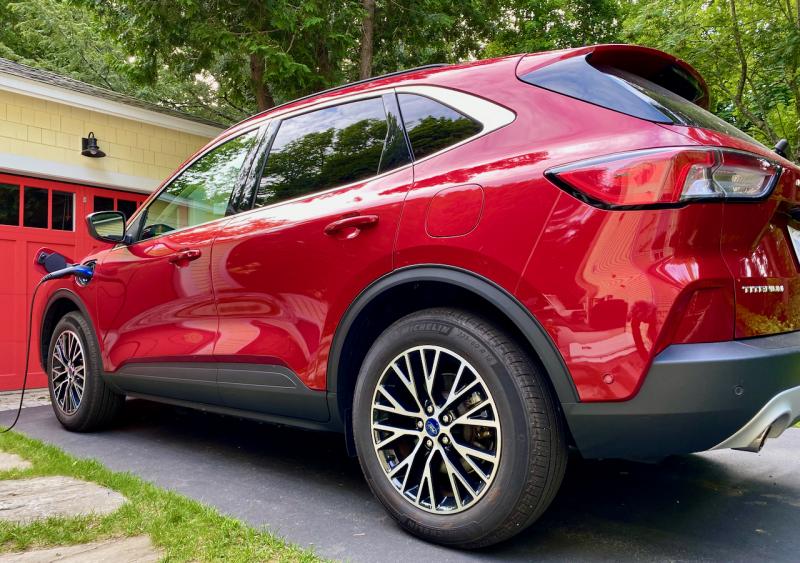Ford Escape Titanium PHEV FWD
 With its recharging port where the driver can’t miss it, no one will try to drive away while the Escape PHEV is still plugged in.
With its recharging port where the driver can’t miss it, no one will try to drive away while the Escape PHEV is still plugged in.
 The demand for electric vehicles is surging as we look to cut our carbon emissions and wean ourselves off expensive gasoline. But the choices can be confusing: hybrid, plug-in hybrid or electric-only? How easy is recharging? What about tax incentives? How do the costs really compare? To answer these questions, especially for families in northern New England, The Nature Conservancy (a notably level-headed organization) has just published a 33-page Rural EV Adoption Toolkit.
The demand for electric vehicles is surging as we look to cut our carbon emissions and wean ourselves off expensive gasoline. But the choices can be confusing: hybrid, plug-in hybrid or electric-only? How easy is recharging? What about tax incentives? How do the costs really compare? To answer these questions, especially for families in northern New England, The Nature Conservancy (a notably level-headed organization) has just published a 33-page Rural EV Adoption Toolkit.
 With its recharging port where the driver can’t miss it, no one will try to drive away while the Escape PHEV is still plugged in.
With its recharging port where the driver can’t miss it, no one will try to drive away while the Escape PHEV is still plugged in.
 The demand for electric vehicles is surging as we look to cut our carbon emissions and wean ourselves off expensive gasoline. But the choices can be confusing: hybrid, plug-in hybrid or electric-only? How easy is recharging? What about tax incentives? How do the costs really compare? To answer these questions, especially for families in northern New England, The Nature Conservancy (a notably level-headed organization) has just published a 33-page Rural EV Adoption Toolkit.
The demand for electric vehicles is surging as we look to cut our carbon emissions and wean ourselves off expensive gasoline. But the choices can be confusing: hybrid, plug-in hybrid or electric-only? How easy is recharging? What about tax incentives? How do the costs really compare? To answer these questions, especially for families in northern New England, The Nature Conservancy (a notably level-headed organization) has just published a 33-page Rural EV Adoption Toolkit.
There’s no need to rehash last week’s explanation of PHEVs—Plug-in Electric Hybrid Vehicles—but here we get a close look at a second one, a Ford Escape that also has a recharging cable, an electric motor and a larger battery. How does it stack up against last week’s brilliant Hyundai Tucson PHEV? Both are compact two-row crossover SUVs with similar drivetrains.
Not so well, in fact. The Escape is considerably less refined than the Tucson, and there can be no comparisons with Rolls-Royces this time. This is not to say that the Escape PHEV has no redeeming qualities; it does, and chief among them is its electric drive, which Ford says is good for up to 37 gasoline-free miles before the battery pack must be recharged, by household current at home or the internal-combustion engine while underway.
The ICE fires up to help whenever speed, gradient or load exceed the electric powertrain’s current (ahem) capacity. On a recent drive on hilly back roads, we managed 23.3 of the total 26.6 miles on voltage alone. The ICE’s occasional input was seamless, with no discernable noise or vibration. Driving the Escape PHEV is thoroughly pleasant and exactly what we expect from a daily-driver family vehicle.
This Escape’s gas engine is a 2.5-liter Four; with the electric motor, the maximum output is 200 horsepower (measured on 93-octane fuel, although Ford recommends 87-octane). Ford declines to provide a torque figure, so let’s just say “enough.” This is the same package found in the non-plug-in Escape Hybrid; the difference between the two is that the PHEV has a larger, 14.4-kWh battery. The plug-in Escape is noticeably slower than the similar Tucson, but it should travel farther on electricity alone. The EPA rates the Escape PHEV for 105 MPG-e (on gas and electricity) or 40 MPG on gas only.
Hybrid and PHEV Escapes are equipped with continuously variable automatic transmissions and regenerative braking. The hybrid Escape is available with all-wheel drive; the PHEV is front-wheel-drive only.
As a premium Titanium model, our Escape had comforts and conveniences that not long ago were found only on very costly cars and that we now take for granted. Despite this, the Escape feels inescapably bargain-basement—and even more so on the heels of last week’s Hyundai Tucson.
Ford Fans will want to know: Is this a fair, apples-apples comparison? Glad you asked. The plug-in Tucson was a loaded Limited AWD with a relatively hefty (for a Hyundai) MSRP of $44,640. This Escape is also a top-of-the-line plug-in, with an MSRP of $43,025—but only with front-wheel drive; AWD is not available. The Escape is also slightly smaller than the Tucson, with less legroom front and rear.
The Escape PHEV is available in three trim levels—SE and SEL as well as Titanium—at starting prices below $36,000. (Again, just like the Tucson.) Considering the tremendous impact that electric vehicles—the F-150 Lightning and the Mustang Mach-E—are having on Ford’s sales, and that the Escape was last updated two years ago, it’s likely that a fresh electrified Escape is on the drawing boards right now.
























